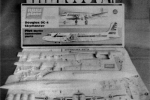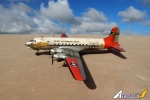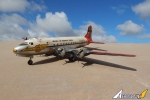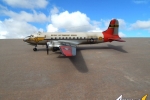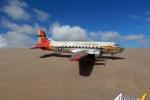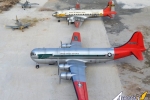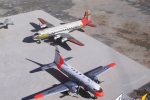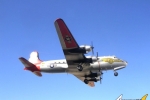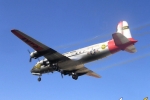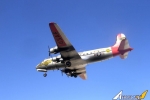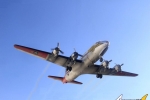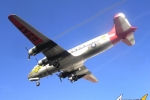1⁄72Skymaster: Douglas C-54
history
In 1942 the USAAF commandeered 24 DC-4 four-engine medium and long range transport from the Douglas production line in Santa Monica which were initially destined for civil airline use. At that time these aircraft were the ideal type to satisfy Army’s requirement for a fast freight and passenger movements to South East Asia. A total of 1088 C-54s were completed which went to the USAF and US Navy, besides many Air forces in South America and also Denmark, Portugal and Turkish AFs. They all had the same basic shape and the only variation being the shape of the radar nose and aerial arrays on top and underneath the fuselage.The colour schemes worn by the military C-54s were very diverse and some quite unique and colourful. The USAF C-54s operated by the MATS carried the yellow forward fuselage motif on the nose and yellow/blue sphere at the rear fuselage on otherwise all metal finish. Later versions had white upper fuselage which was separated from the lower metal finish fuselage by a blue cheat line. Some even carried international orange tail fin and tail planes. These served with the MATS Atlantic Division and Pacific Division that operated close to the Arctic Circle and Antarctica. The SC-54, a type adopted for air-sea rescue missions’ way back in 1955 carried a large transparent blister on starboard side, aft of wing root besides many internal changes in equipment. These were finished in light grey overall with a yellow band outlined in black at the rear of fuselage. The nose, wing tips had Day-Glo patches, ‘Rescue’ band in black outlined in yellow with wording in white. 11 C-54s were supplied to the RAF in 1944 for use by transport command on routes to the Far East with 232 and 246 Squadrons before being returned with other land /lease aircraft at the end of the war. Among the C-54s was also a particular historic one serial No 42-107451, which was converted for Presidential use, by both President Roosevelt and then President Truman. The VIP aircraft had four in built state rooms and a conference room. President Truman named the aircraft,’Sacred Cow’ and is known to have visited 55 countries between 1944-47. Attractive colours also appeared on US Navy Skymasters, designated R5D-3. These had white top fuselage and silver lower surfaces parted by a dark blue cheat line. A US flag on tail unit with code letters and serial numbers in black on tail and nose areas. Decorative colours also appeared on C-54 operated by the Blue Angels, while attractive bright orange areas decorated the type operated by the USCG. R5D-3 Skymaster serving on Antarctic operation ‘Deep Freeze’ in 1958 attached to VX-6 and based at NAS Quonset point had mid grey upper fuselage, dark grey radar nose, aluminium lower fuselage and main planes with rear fuselage, fin and tail planes are Day-Glo red. South African AF ones were also camouflaged in dark earth and green.
The C-54 was powered by four Pratt & Whitney R-2000-7 or-11 radial engines of 135HP or the C-54G, S, T by R-2000-9 radial engines of 1450HP. The C-54D had a maximum speed of 274mph at 14,000ft. Normal cruising speed was 239mph t 15,000ft and a maximum range of 3,900 miles. It carried a crew of five and 14.28 Tons of freight or up to 50 fully equipped troops. The Argentine Air Force and Navy and the Air Forces of Brazil, Columbia, Congo, Denmark, Ethiopia, France, Aeronaval, Portugal, Spain, Thailand, Turkey, USN, USAF, VENEZUELA and RAF operated the C-54. The variants in service with the USAF included the C-54A, D, E & G, and EC-54D with special electronics installation, HC-54D for search and rescue, TC-54D for training and VC-54D. The Skymaster had a span of 117’1”, a length of 98’ 11”, and a height of 27’ 61/2”. The C-54 remains in many peoples minds and is the type that brings back many memories of the past be it in Korea, or during the Berlin or spotted at Keflavik, Mildenhall, or incoming into Luqa airfield, Malta for a stop over after a fairly long flight from Rota, Wheelus or nearby Sigonella back in the early 60s.
the model
Packed in a sturdy box with a picture of the C-54 (DC-4 in Capitol Airlines markings), the kit comes in sheets of white vac-form plastic complete with a large two page ‘Guide’ to assemble the model. As with all previous Rareplanes kits that I made the instruction sheet has all the hallmark of ‘Gordon Stevens of Rareplanes’ style of presentation with accurate scale plans, suggestions for different colour schemes, clear oblique exploded views and my model contained a set of fine decals covering a US Air Transport Service machine. I say ‘in my box’ because apparently alternative decals could be purchased for a nominal fee to make a civil or other military colour scheme as advertised in the Guide sheet. There are seven stages of assembly to follow so that one can do a C-54 or a Navy R5D-3 Skymaster. The detail on the surface of the vac-form kit parts was among the best I have ever come across on vac-form kits. This was evidence of how detailed vac-form kits have become considering that the kit was released some 45 years ago or so. Detail that in my opinion is all superior even to the best expensive resin kits we find on the market these days. Apart from the C-54 which was powered by American built engines there is included a bonus of parts to build a set of Merlin engines to enable one to build a Canadian Forces version as C-54G, DC-4M-1/2 and C-4. Alternatively one can go for a Navy R5D-3 attached to VX-6 of operation Deep Freeze with a colourful finish.The C-54 kit has long disappeared out of circulation and I reckon that if Rareplanes at the time decided to produce another 1,000 more kits, these would have been sold in a short period of time. Upon making this somewhat large model I realised that this did not involve all that more work than when making a smaller vac-form kit. I went about building the model in the following procedure. The white plastic is first marked with a soft pencil around each vac-form part and is then scored with a sharp knife making a light cut around the outline of the moulded part. Each part is then bent and the excess backing plastic is snapped away with fingers or a small pliers. All cut edges are next sanded flat on a medium wet and dry sanding paper which is large enough to take the whole length of fuselage, and which is stuck with a double-sided tape to a backing piece of wood. Adding plenty of water makes sanding action smoother. As each part is sanded correctly, a thin line of ‘flash’ will break away from the component. This is a good indication as how far you need to go down in sanding. Frequent checking will ensure that one do not over sand and one also has to ensure a perfect joint line between pats. Much heavier sanding is required on trailing edges of rudder, wings, and elevators to obtain sharp edges. All moulding ‘pips’ are cut off with a sharp razor blade before assembly. Liquid cement is used to join parts together but tube cement is recommended for the sturdier joints.
I first assembled the engines which consists of cutting out the cowlings and removing the circular front; cut out the air screws and sand to shape, cut out front of coolers and radiators and trim the radial piston engine parts so that they will fit to the bulkhead integrated with the wing assembly. The mainplanes half assemblies follow this. It is suggested to add a block or a complete spar of balsa wood in order to maintain the correct wing section depth. The tailplane parts assembly was a straight forward job, then sanding flat the root end to fit fuselage at a later stage. Next come the fuselage halves where the cockpit area was cut to receive the clear Perspex piece provided. The oval shaped side fuselage windows were carefully drilled and shaped with files to conform to a common template made of wood having a section conforming to the shape of window apertures that are all similar. The cockpit office consists of a floor held between two bulkheads. Coaming, seats, control columns, console were carefully added and painted in cockpit green, leather brown seats, and shades of grey and black to the surrounding instruments. The forward undercarriage bay was cut and the nose wheel, made from vac-form parts provided with torque links made from stretch sprue was dry run. Nose weight wrapped in tissue paper was inserted forward of bulkhead. Two rear bulkheads were cemented with tube cement. Alternative strips of plastic were added along the fuselage halves joint. The interior was painted cockpit green and after drying rectangular areas was cut at wing root on fuselage to allow wing stubs to fit into.
The fuselage halves were now carefully joined together and allowed to dry, securing them with masking tape wrapped around the assembly. As this was drying, other parts were attended to. The main landing gear was trimmed, carefully detailed and painted. Before cementing the undercarriage legs, a metal rod was added as vertical strengtheners and as an axle to cement wheels to. The wheel well contained two large and two small doors, which were to be fitted around the undercarriage openings. Separate air scoops were added over the top of each nacelle. Exhaust pipes were made from curved sprue rod and cemented to lower of nacelle. As for the propellers mentioned earlier the instruction sheet suggests that one could use a set from the Revell B-17 kit. The main wings and tailplanes were now joined to the fuselage. Putty was applied to the wing roots and centre line of fuselage. These were then sanded smooth and a light brush coat of liquid cement applied to smooth down the joints. One makes sure that the wing had the right dihedral angles according to the plans provided and that the engine cowls are correctly aligned with the rest of the nacelles. The undercarriage is then fitted in place and correctly positioned from front view and side view. All the transparent cockpit areas and astrodomes were fitted and masked so that they are not scratched or marked during assembly. Loop and bullet antennae and aerials made from metal pins of correct length were added at this stage.
painting and finishing
The upper fuselage was given two coats of Humbrol satin white, with fine smooth sanding in between and after final coat. Tail planes and fin and wing tips were also airbrushed in white. These areas were afterwards coated in high visibility international orange from Tamiya brand paint. All these areas were carefully masked and the rest of fuselage and wings were airbrushed in Hampel brand of silver mixed with 15% varnish and a few drops of white. Areas in line with exhausts and oil leaks were given fine coats of spray mix of matt varnish, thinner and few drops of engine grey. The kit was then allowed to set dry for 24 hours after which it was ready to receive the decals. The quality and adhesion properties of the decals were superb though they were a tiny bit on the gloss side. The offer of de-icing boots as black stripes and curves made decalling so much easier. Black walkways were not supplied but the scale plans showed these to best advantage and were made from matt black strips using Micro Scale black decal of correct width and cut to required length. Prop blades were painted silver with standard yellow tips.conclusion
Having produced the C-54 much to my satisfaction I come to form an opinion that this was one of Rareplanes' masterpieces and I simply managed to get my kit just in time when they were about to be sold out. Kits by Rareplanes, Airmodel, Formaplane and Esoteric which were so much on the market some years ago have added a great deal of potential to the scale modelling hobby and immensely expanded the range of kits that one would go for. Kits produced by Rareplanes remain truly magnificent. DC4/C-54 was a truly work of art and remains a fine example of 1/72 scale vac form technique. Thank you, Rareplanes.Copyright ©2021 by Carmel John Attard. Images also by copyright holder unless otherwise noted. The views and opinions expressed herein are solely the views and opinions of the authors and/or contributors to this Web site and do not necessarily represent the views and/or opinions of AeroScale, KitMaker Network, or Silver Star Enterrpises. Images also by copyright holder unless otherwise noted. Opinions expressed are those of the author(s) and not necessarily those of AeroScale. All rights reserved. Originally published on: 2014-02-08 00:00:00. Unique Reads: 5575





